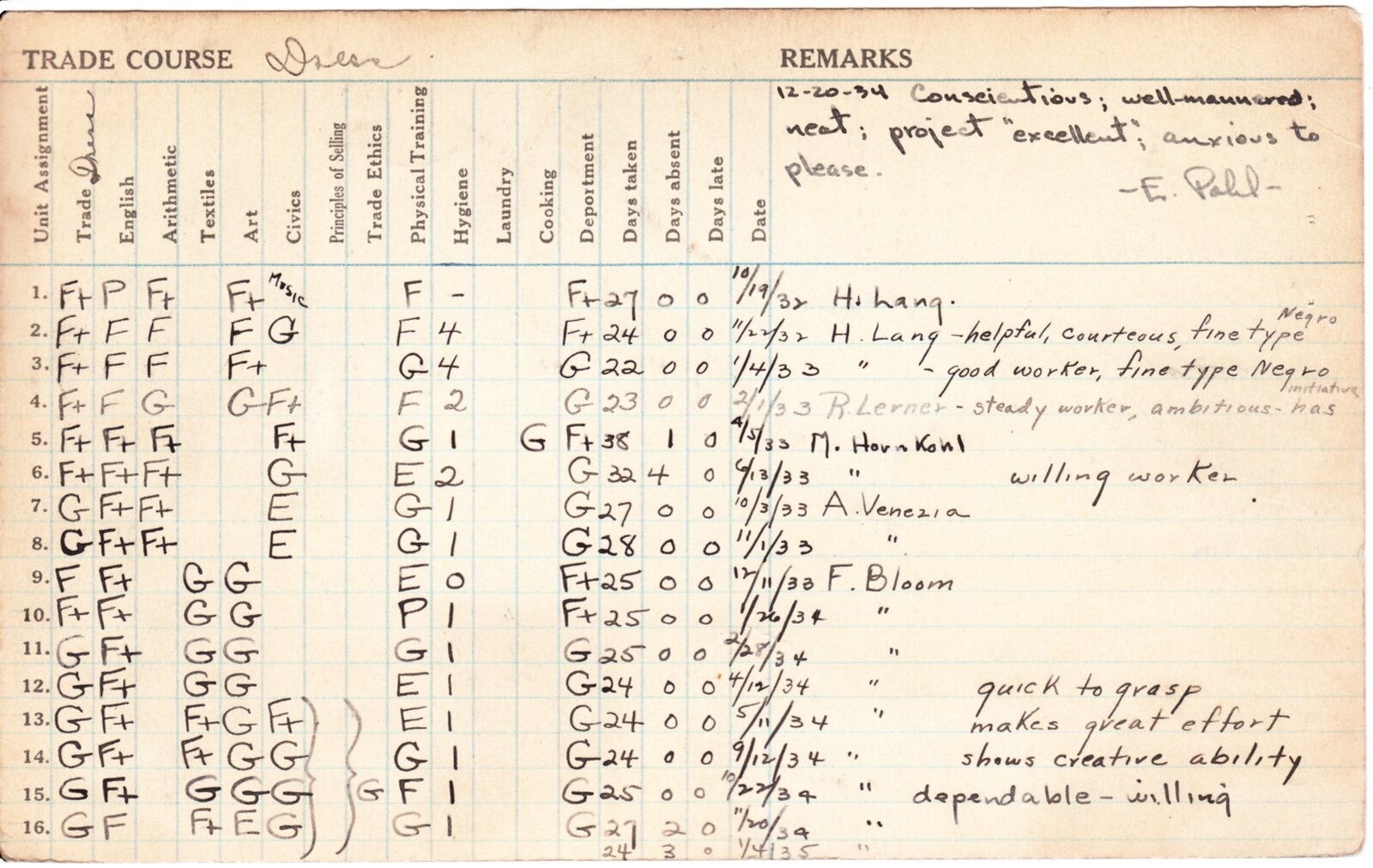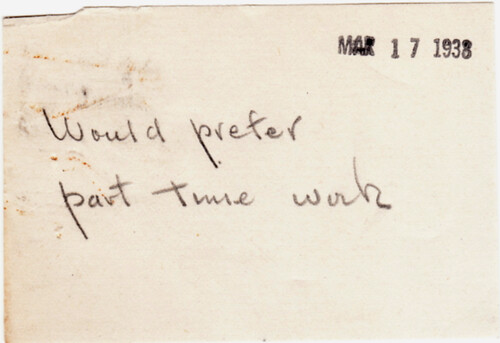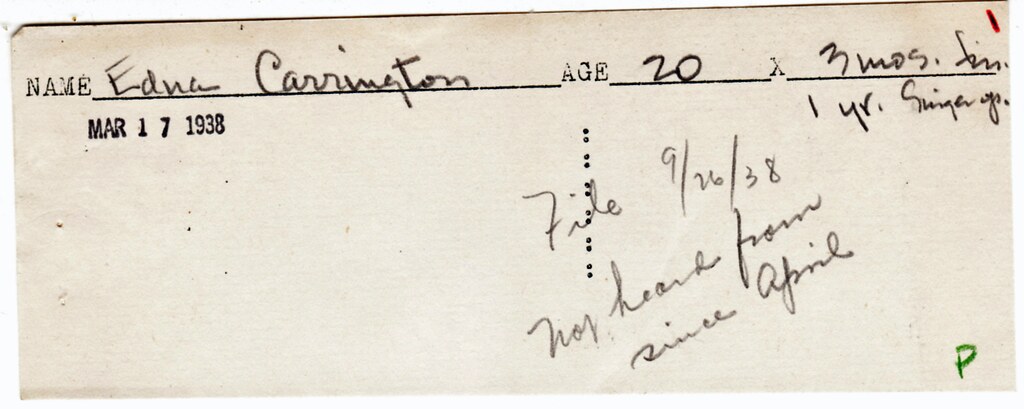
The latest Manhattan Trade School student whose record we'll be examining is Edna Carrington. She differs from our previous students of the week in at least three important ways: (1) Her report card includes a photo, which makes her story much more evocative. (2) She was born in 1917, which means there's a vague chance she could still be alive. Interestingly, her date of birth was revised at some point, from Feb. 4 to April 15. (3) She was black, and apparently Caribbean. In the "Nationality" field, near the upper-right corner of the card shown above, it says "English (West India)."
As you can see, Edna's card also includes a prominent black dot. This was standard on the cards of all the black and Hispanic girls in my collection — literally a black mark on their records. The dot system was instituted before the school began including photos on the girls' cards (and was retained even after the photos became part of the cards' protocol), so it was a quick way of identifying students of color. At first this seemed horrifying, but I eventually determined that it was more of a "Handle with Care" warning to the school's staff, because the school wanted to avoid sending the girls to work with employers who were known to have issues with minority students.
There are several other notable things about this card:
• Toward the bottom is a notation indicating that Edna wore glasses, although she didn't wear them for her photograph.
• There are several notes regarding Edna's home life, where she was raised by a single mother. She had three younger siblings, and the family lived in a three-room apartment, which was apparently visited several times by the Board of Child Welfare. (As we'll see on a subsequent card, this doesn't indicate that anything problematic was taking place in the home.)
• Edna was one of the students who stayed in touch with the school long enough for her eventual married name to be added to her student record. As you can see at the top of the card, her husband's name was F. Meyer.
• Toward the middle of the card is a note indicating that Edna gave birth to a child on April 25, 1937.
• This card features a jumble of many different people's handwriting, but the first person to fill out Edna's name, address, and parents' names and occupations had seriously beautiful penmanship. Gorgeous to look at!
So that's the first card. Now let's turn it over and take a look at Edna's grades and teachers' comments (remember, E = Excellent, G= Good, F = Fair, P = Poor):

As you can see, Edna generally got solid grades and was very well liked by her teachers (although the repeated "fine type Negro" comment is distressing to see).
The school arranged employment for Edna, just as it did with other students. Here's her work record:

The first and third entries are both for an employer called the Margalo Dress Shop. The third entry includes the following notation: "Edna says she gave notice, but employer says she fired her. See above." That apparently refers to the note at the top of the card, written in red (meaning that it's a comment from the employer): "Very dirty — spoken to several times about taking baths. Leaving Saturday, April 13." Yikes.
Interestingly, Edna's file also includes a note from this same employer, dated April 4, 1935 (nine days before she was apparently dismissed for lack of cleanliness):

It reads as follows:
Manhattan Trade School:
Edna Carrington came here the first part o January and left the 1st of February or thereabouts.
She came back here to work April 1st.
Yours truly,
Margalo Inc.
No mention there of the cleanliness issue. It must have come to a head over the next week or so.
Also of note: If you scroll back up to Edna's employment record, you'll see that the last entry is for a "W.P.A. Project" job. It says that she found the position via "Home Relief," which was the principal New Deal welfare program during the Great Depression. The pay — $16.50 per week — appears to have been better than what Edna had earned during her previous gigs.
Edna's student packet also includes a salmon-colored card. Some of the student files in my collection had this card, some didn't. It appears to be a basic summary or assessment of the student, which in Edna's case was generally positive:

Three notable things here:
• Someone felt the need to write, "Skin not terribly dark, but full of blemishes." Sigh.
• Someone also wrote, "Superior type." The school's report cards were full of these "type"-based assessments — fine type, decent type, quiet type, and so on. I'm pretty sure this was all just a form of lazy, reflexive social profiling, not a strict classification system.
Toward the bottom, the card indicates that Edna's mother worked to support the family, but then that part was crossed out. Did the mother lose her job, or become ill? In any case, the next line says that Edna "would like a job as soon as she can get one," presumably so she could become the family's breadwinner.
If we turn this card over, we learn more about the visits to the home by the Board of Child Welfare:

In case you have a hard time reading that, here's a transcription (I've spelled out some abbreviated terms for clarity):
Dec. 21, 1934: Board of Child Welfare pays $45 a month for two youngest children. Rent is $5 a week. Mother has not worked in two years.
Sept. 13, 1935: Child Welfare pays only $25 a month now.
March 17, 1938: Married Oct. 14, 1936.
So that explains the Child Welfare Board visits. But I'm more interested in the last entry — the one about Edna's marriage. Remember, the first card in her packet indicated that she gave birth to a child on April 25, 1937, which is six and half months after the date listed for her wedding. So her child was either significantly premature or conceived out of wedlock, which would have been scandalous in those days.
It's also noteworthy that the news about the 1936 wedding was apparently conveyed to the school in 1938. So Edna must have been out of contact with the school for a while and then circled back. Why? She was apparently looking for work again:

It's interesting to see that Edna wanted to work even after marrying and having a child. Most of the students whose lives I've researched stopped working once they began a family, but this was during the Depression, and we've already seen that Edna had obtained a job via Home Relief, so times were apparently tough for her and her husband. Still, Edna's employment record (the yellow card we looked at earlier) doesn't show any work during 1938, so the school apparently didn't arrange any jobs for her during this period. This doesn't necessarily mean she didn't work; it just means the school didn't find a job for her. By that fall, she'd drifted out of the school's orbit once again:

That's the end of Edna's student record. Interesting stuff, right? Since we know Edna's married name, she would probably be relatively easy to research, although I don't have time pursue that now. But if anyone else wants to pick up the baton, please feel free.

there is an Edna Meyer with husband Fred and daughter Arline in the 1940 census at the same address on the card (64th St.) Also found info on an Edna Meyer (born Feb. 4, 1917-the same date marked out on the card) living in the Bronx as of Jan. 1, 1998 with an Arline Meyer and a Terencio Meyer listed as possible relatives. Sounds like her to me, but I have limited research capabilities to verify any further.
ReplyDelete